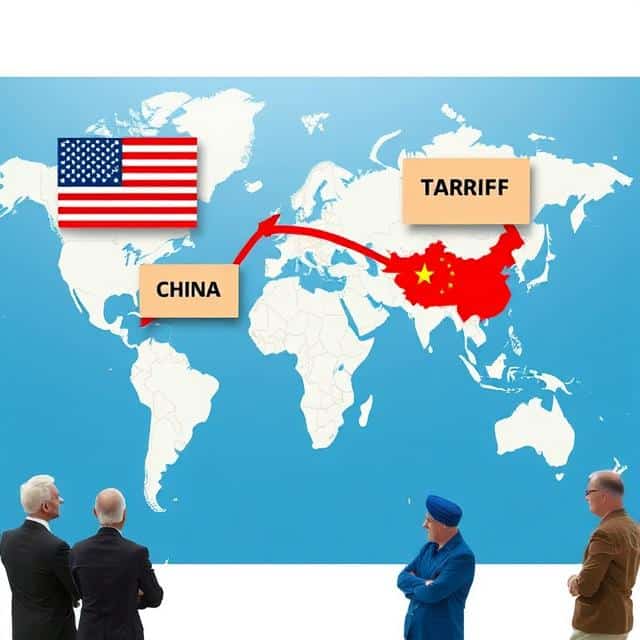Imagine you’re running a small business selling handmade bags. You get your raw materials from another country because they are cheaper there. Now, imagine the government suddenly imposes tariffs on those imported materials.
This tax is called a tariff. What happens next? Your costs go up, you either raise your prices or reduce your profits, and consumers may end up paying more. This is a simple example of how tariffs work and affect economies.
Now, let’s break down tariffs and their broader impact on the world economy in a simple and engaging way.
What Are Tariffs?
A tariff is a tax imposed by a government on goods and services imported from other countries. Tariffs are a powerful economic tool that governments use to influence trade and protect their domestic industries. When tariffs are imposed, they directly increase the cost of imported goods, making foreign products less competitive compared to local alternatives. Tariffs, therefore, serve as a shield for domestic businesses, helping them survive against international competition.
However, tariffs also have broader effects beyond just protecting local companies. The introduction of tariffs often leads to higher prices for consumers, as businesses pass on the increased costs caused by tariffs. This can reduce consumer purchasing power and slow down overall economic growth. Moreover, tariffs affect global supply chains by encouraging companies to source materials and products from within their own country or from partners with lower or no tariffs, which may not always be the most efficient or cost-effective option. Over time, tariffs can distort markets and reduce global economic efficiency.
The timing of tariffs is crucial—sudden or unexpected tariffs can disrupt trade flows and create uncertainty for businesses that rely on stable supply chains. On the other hand, gradual or well-communicated tariffs can give companies time to adapt and find alternatives. Governments often use tariffs strategically during times of economic tension or geopolitical conflict, making tariffs not just economic tools but also instruments of diplomacy and national security. However, the use of tariffs can provoke retaliation in the form of counter-tariffs, leading to trade wars that further escalate costs and hurt global trade.
The impact of tariffs is felt by producers, consumers, and entire economies alike, making tariffs a key factor in international economic relations. Understanding tariffs and their multifaceted effects helps businesses, policymakers, and consumers navigate the complex global market shaped by these ever-present trade taxes called tariffs.
The main reasons countries impose tariffs are:
-
To Generate Revenue: Governments earn money from tariffs, which is why they are an attractive tax option.
-
To Protect Domestic Industries: Tariffs make foreign products more expensive, encouraging consumers to buy locally made goods.
-
To Reduce Dependence on Foreign Goods: Countries may use tariffs to become more self-sufficient, especially in times of conflict.
-
To Address Trade Imbalances: Tariffs can help reduce the amount of money flowing out of a country due to excessive imports.
However, tariffs come with side effects, both good and bad. Let’s explore them.
 First-Order Consequences of Tariffs
First-Order Consequences of Tariffs
1. Who Pays for Tariffs?
When a country imposes tariffs, both the foreign producer and the domestic consumer bear the cost. How much each pays depends on how sensitive (elastic) they are to price changes. If the consumer has no alternative but to buy the foreign product, they bear most of the cost.
If the foreign producer has no other market to sell to, they bear most of the cost.
2. Tariffs Reduce Global Efficiency
Think about how a factory works best when it sources materials from the most efficient supplier. If tariffs force businesses to buy locally at higher prices, production becomes inefficient. This inefficiency reduces overall global productivity.
3. Tariffs Lead to Stagflation
Stagflation = Stagnation (economic slowdown) + Inflation (rising prices)
-
The country imposing tariffs faces inflation because imported goods become more expensive.
-
The country facing tariffs sees deflation because demand for its exports falls.
-
The overall effect on the world is stagflation, as global trade slows and costs rise.
4. Tariffs Protect Local Businesses, But at a Cost
By making foreign competition more expensive, tariffs protect domestic businesses. However, protection leads to complacency. When businesses don’t face competition, they don’t innovate or improve efficiency.
They survive only as long as the government keeps tariffs high.
5. Tariffs Are Essential in Global Conflicts
In times of war or geopolitical tension, countries impose tariffs to ensure they have essential industries within their borders. For example, if a country relies on another for steel, it might impose tariffs to encourage domestic steel production for security reasons.
6. Tariffs Reduce Trade and Capital Imbalances
Trade imbalances happen when a country imports much more than it exports. Tariffs reduce imports, helping to balance trade.
Similarly, capital imbalances occur when a country relies too much on foreign investments. By reducing reliance on foreign goods and investments, tariffs make a country more self-sufficient.
Second-Order Consequences of Tariffs
The first-order effects of tariffs are immediate, but there are ripple effects depending on how different countries respond. Here’s what can happen next:
1. Retaliation with Counter-Tariffs
If one country imposes tariffs, the other may respond with tariffs of its own. This back-and-forth leads to a trade war, hurting both economies. Prices rise, businesses suffer, and global trade slows down.
2. Currency Fluctuations
Countries respond to tariffs by adjusting their currencies. If a country faces deflation due to tariffs, its central bank may lower interest rates, weakening its currency. A weaker currency makes exports cheaper, partially offsetting the impact of tariffs.
Meanwhile, countries imposing tariffs may raise interest rates, strengthening their currency but making their goods more expensive abroad.
3. Changes in Government Policies
Governments may respond to tariffs with fiscal policy changes:
-
If tariffs slow down an economy, governments may increase spending or cut taxes to stimulate demand.
-
If tariffs cause inflation, governments may reduce spending or increase taxes to control price rises.
The Bigger Picture: Global Economic Shifts
1. Debt and Trade Imbalances Must Be Addressed
The world has been running on unsustainable trade and debt imbalances.
Countries like the U.S. borrow heavily and import more than they export, while countries like China lend money and export more than they import. These imbalances are risky and must be reduced to avoid financial crises. Tariffs play a key role in adjusting these imbalances.
2. The World Economy Is Changing Unconventionally
Big shifts in global power and economics don’t happen smoothly. Countries are moving towards protecting their economies more aggressively, leading to unexpected economic policies, tariffs, trade restrictions, and financial system changes.
3. Long-Term Stability Depends on Trust in Financial Systems
People and businesses invest in countries they trust. Trust is built on three pillars:
-
Attractive Political and Economic Systems: If a country is unstable or unfriendly to investors, capital will flow elsewhere.
-
Stable Debt and Capital Markets: Investors need to feel confident that their money is safe.
-
Strong Productivity: A country must produce valuable goods and services efficiently.
The Role of the U.S. Dollar in This Equation
The U.S. dollar is the world’s main reserve currency, meaning most global trade and investments are conducted in dollars. This gives the U.S. a financial advantage but also encourages excessive borrowing. Over time, this over-borrowing leads to financial instability and global economic shifts.
Some argue that China’s currency (the RMB) should appreciate, making Chinese goods more expensive and reducing trade imbalances.
Such adjustments could be negotiated between global leaders like the U.S. and China, but they come with their own economic consequences. Tariffs often become tools in these negotiations.
Final Thoughts
Tariffs are like a double-edged sword. They can protect domestic industries, reduce trade imbalances, and prepare a country for economic conflicts.
But tariffs also lead to inefficiency, inflation, economic slowdowns, and potential trade wars.
The real challenge isn’t just tariffs themselves but how countries respond to them.
Trade policies, currency movements, interest rates, and government spending all interact in complex ways, shaping the global economy. Understanding these interactions helps us make sense of economic changes and their impact on businesses, consumers, and global markets.
🌐 For more expert analysis and updates, visit smifs.com



 First-Order Consequences of Tariffs
First-Order Consequences of Tariffs



